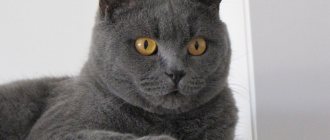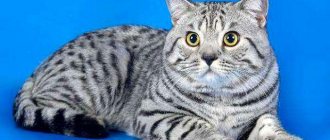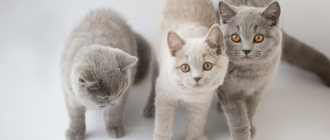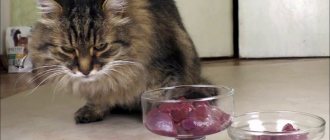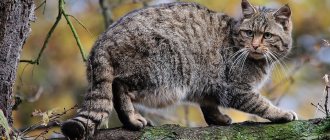Video
* We invite you to watch a video about the Oriental cat . In fact, in front of you is a playlist in which you can select and watch any of 20 videos about a given cat breed by simply clicking on the button in the upper right corner of the window. In addition, the material contains quite a lot of photos. By looking at them you can find out what an Oriental cat looks like.
Rate the material!
[Total votes: 0 Average: 0]
The Oriental cat is an amazing animal that has an unusual appearance. Cats have huge ears, the shape and size of which is unusual for other breeds. Thailand is considered the animal's historical homeland. Such cats can become excellent friends for both children and adults. They are distinguished by friendliness, plasticity, grace and curiosity. Before getting such an unusual pet, it is recommended to study the characteristics of its character and care for it.
Games and devotion of Orientals
They love to play with interactive toys such as balls, swings, and various fishing rods. As they grow up, the playful nature of Oriental cats does not change and they continue to delight their owners with their unpretentious behavior.
The oriental character of the breed is revealed in their devotion, which they keep only to one person. It is to him that they give maximum attention and love. Orientals are good travel companions, most importantly with their beloved owner.
Another character trait of Oriental cats is their unbridled curiosity. They stick their noses everywhere. Not a single incident in the house can happen without them. If guests come to you, they will not hide, but will be happy to get to know everyone, and will make even the most indifferent to the cat family fall in love with them. Orientals also easily get along with any pet, especially with other representatives of their breed.
History of the origin of oriental cats
The historical homeland of this amazing cat is Thailand. The first mention of the mysterious cat dates back to the 13th century AD. They were mentioned in a “collection of poems about cats.” For several centuries, the country's authorities at the legislative level prohibited the export of such exotic animals from the country. In this regard, in other countries no one knew anything about them and had never seen them.
Oriental cats first came to the New World only in the 19th century. In London, a cat and a cat of this breed took part in an exhibition that took place in 1894. However, these cats were disqualified. The description that the exhibition staff compiled about the amazing, unknown animals is still preserved: “representatives of the Siamese breed with a chestnut color and a green iris.” Cats of this breed were considered Siamese and were excluded from participation due to non-compliance with the standard.
A similar situation occurred two and a half years later in England. The organizers of the exhibition excluded the cats from participation due to identical coat color to Siamese cats.
Interesting fact: In the 50s of the 20th century, Baroness Edith von Ullmann and Mrs. Armitage Hargraves decided to breed this breed of cats. It is to these women that cats owe their origin and distribution. The first kittens to be bred were chocolate colored. Then we managed to get blue, beige and all other colors.
To obtain the necessary colors, breeders crossed representatives of Siamese cats with representatives of many other breeds - Russian Blue, Abyssinian. It is noteworthy that ordinary outbred black cats were also used for selection. After the appearance of new flowers, interest in cats began to grow. In 1977, oriental cats were officially registered.
A hundred-year path to recognition
If you translate it, the name of the breed sounds like “oriental cat,” and this is no coincidence, because the homeland of this graceful animal is Thailand. For a very long time, on pain of death, its export from the country was prohibited, but nevertheless, the desire of many rich people to have such a pet led to the fact that they appeared in England. This event happened in the 19th century.
However, for a very long time they were not recognized as thoroughbreds; all phenological councils completely denied the appearance of this beauty as an official representative. For some reason, it was generally accepted that only the Siamese breed was worthy of attention. Such an offensive phrase, preserved from the time of the exhibition in 1894, is documented. It was said about the Oriental cat that it is just a Siamese cat of chestnut color.
Another attempt to introduce a new breed was again met with complete misunderstanding. This happened at an exhibition held in 1896. The presented beauty was disqualified, again, because of her special color, as she was equated to the standards of her Siamese brothers.
And when in 1956 an American breeder decided to take an Oriental cat from the nursery for testing, trying to refine and develop a new breed for official recognition, he was allowed to do so.
The experiment turned out to be quite successful, because after two years the Americans determined the standard parameters of the breed. And when, 8 years later, a chocolate-colored cat became the winner of the competition, it was considered that this color was the most original and at the same time typical. Particular credit goes to Baroness Edith von Ullmann, who put in a lot of effort and, as a result, was able to bring Orientals to the official level, turning many criticisms, especially regarding color, into the merits of the breed. So the Siamese cats had a worthy rival.
Over the years, they tried to refine the breed, attracting Siamese brothers to breeding, which is why since then Orientals have had numerous colors. A long-haired and bicolor variety was then developed, and enthusiastic breeders ensured that all of them were registered and recognized under the FIFE classification.
In 1974, breeders celebrated their victory, because Orientals were officially recognized and registered.
Oriental cat - description of the breed
Oriental cats are medium-sized animals. They have sexual dimorphism. Females are slightly smaller and lighter than males. The average body weight of a cat is five kilograms, and cats are 1-1.5 kilos less. Body height at the withers is no more than 32 centimeters.
Representatives of this breed have a unique appearance that cannot be confused with any other. Those who have once encountered oriental cats will forever remember their external characteristics. Breeders and scientists note some distant similarities with Siamese cats.
Main characteristics of Oriental cats:
- A narrow, elongated, elongated body, on which the muscles are quite clearly visible;
- Graceful, thin and fragile neck;
- The head is medium in size, triangular in shape with a pointed muzzle and a narrow chin. The nose area is framed by a long, bushy mustache;
- The frontal part smoothly merges with the bridge of the nose;
- The nose is wide, noble and straight;
- The eyes are large, very expressive, and almond-shaped;
- The iris of the eye is most often colored emerald, in white cats it is sky blue;
- Animals' ears are very large. They are distant from each other, widely spaced, and are, as it were, a continuation of the wedge-shaped shape of the head. The ears are very wide at the base, tapering slightly towards the tips;
- Well-defined muscles in the limbs and chest;
- Athletic, toned stomach;
- Long, graceful, refined limbs. The hind limbs are slightly longer than the forelimbs;
- Paws are rounded;
- The tail is very long and rather thin, with a rounded tip. The tail length of some individuals reaches 80-90 centimeters;
- The animals have rather thick, smooth and shiny fur. There is practically no undercoat.
Interesting fact: There is a type of Oriental cat that is distinguished by the presence of long hair. This breed was bred by breeders from America in the 80s of the last century.
Appearance of Oriental cats
Short-haired cats: list of popular breeds
The Georgian cat has a long body. Graceful lines create the image of an aristocratic animal. The tail is long. The head is large, triangular in shape. There is no smooth transition from the forehead to the nose. The cat's profile is even. The eyes are large, close-set, almond-shaped. Eye color is related to coat color.
Attention! Strabismus is considered a pathology of this breed.
The nose is big. There is no depression on the bridge of the nose. The kitten may have a slight indentation, but it will disappear over time.
The ears occupy a sufficient area at the base, are large and widely spaced.
The length of the Oriental's limbs is above average. The bones are thin but strong. Oval shaped paws.
The coat is quite short, silky, and not prone to shedding.
Where did the Orientals come from?
Popular colors of oriental cats
Like any other breed, the Oriental cat has a standard set of colors. The most common of them is chocolate. Breeders call it "Havana". Cats of this color are completely colored in a pleasant chocolate color, including even the tip of the nose. Only the tips of the paws are slightly different - they are a little lighter.
Other most common colors are brindle, marbled, tabby, and ticked. According to the standard, in addition to the above, other color options for cats are allowed.
Acceptable cat colors:
- Cinnamon. Coat color is light brown. Almost the entire body is painted this color, with the exception of the tip of the nose and the tips of the paws. They are colored light pink;
- Blue. Ash-smoky color, which resembles the color of Scottish cats;
- Faun. The body is painted in an even, solid beige color, the tip of the nose and paws are pale pink;
- Rich red or red. The body is colored red, the tip of the nose and paws are pale pink;
- Lilac (diluted pink, lavender);
- Black;
- White (considered the rarest). Oriental cats have many different colors. They may have a different undercoat color (smoky color), ears, the tip of the nose and the tips of the paws may have a different shade or color.
Quite often, representatives of this breed are confused with Siamese cats. The most common difference is green eyes. Siamese cats' eyes are always sky blue. Deviation from the standards is considered a defect in the breed.
Appearance Features
It is necessary to consider in more detail the character of the Oriental cat and the description of the breed.
Head size is medium. The ears are large, slightly rounded, wider at the base. During exhibitions, a mandatory condition is that their line smoothly continues the line of the wedge of the head. Kittens of this breed experience active ear growth after birth, so at this age they look very funny. But then their growth stops, and as they grow older, this disproportion disappears. The same thing happens with the nose.
The nose of these cats is long and straight. If even a slight snub is observed, this is considered a defect. The nose should follow the line of the forehead.
The eyes of Orientals are almond-shaped; there are no small depressions between them. Some cats of this breed suffer from strabismus, and such a pet will not be registered at the exhibition. The majority of eyes have only green color or have so-called heterogeneity. But if the color is snow-white, then the eyes will be light blue.
The body is stately and graceful. Its elongation and sophistication are observed. The purebred Oriental has strong muscles. The belly is lean. Cartilage appears in the chest area. The hind legs are longer than the front legs.
The weight of a cat is from 6 to 8.5 kg, a cat’s weight is no more than 5 kg.
Character and habits of oriental cats
Oriental cats are very sociable, playful and active animals. They love attention and love to be the center of it. They will constantly demand a lot of attention from their owner, regardless of his busyness and workload. Animals love tactile contact. They love to be on their owner's lap. They will be happy if the owner strokes and caresses them.
Oriental cats are often called “talkers.” It seems that they really know how to talk. The owners note that they accompany almost all their actions with a wide variety of sounds. It is characteristic that animals can pronounce a fairly wide range of different sounds: hissing, grunting, meowing, purring, etc.
Oriental cats are distinguished by their intelligence and intelligence. With them you can learn a wide variety of games and exercises. They are very inquisitive. They are of great interest to the window behind which there is constant movement. Cats can sit by the window for hours and watch what is happening outside. Another trait of animals is curiosity and curiosity. They are incredibly attracted to closed drawers, cabinets, and boxes. They will definitely climb into them to see what is hidden there.
Interesting fact: Oriental cats are incredibly touchy. They inherited this quality from Siamese cats. If someone offends them, they will demonstrate indifference and indifference to their offender, although in fact they will suffer greatly from the offense.
Cats become very attached to their owner. They find it hard to bear his long absence. Animals get along quite easily with other animals, as well as with cats of other breeds, if they grow up with them from childhood. It is unusual for them to show aggression, or to defend and defend their territory too fiercely.
Oriental cats can get along with children quite easily. It cannot be said that they are immeasurably patient with children; rather, they are patient with such family members. They will never offend a child, but they will not allow them to invade their personal space, which is inviolable for them.
Oriental cat character
Oriental cats are energetic and self-sufficient. They have a rather reserved character, they are not particularly affectionate, but they are very devoted to their owner and are incredibly afraid of loneliness. Orientals have a well-developed sense of independence, but at the same time they are attached to their owner.
Orientals love to run and play; they are a very curious breed. They will examine every thing in the house, open all the cabinets, and take out some things that are interesting to them. They cannot be raised using brute force - they are very sensitive animals.
Oriental does not tolerate moving or changing owners well. He doesn't like to go for walks and prefers to play at home. At the same time, representatives of this breed are quite talkative. There is a myth that Orientals have an unpleasant, harsh voice, but this is far from true. They often purr and purr, but can also meow loudly. Their voice is unusual, but not unpleasant.
Interesting facts about oriental cats
Cats have many interesting features:
- Oriental cats are considered hypoallergenic, so they are suitable even for those who are allergic to cat fur;
- Representatives of this breed are called rainbow cats all over the world, as they have a huge number of colors;
- Cats are not able to withstand cold and frost due to their short hair and lack of undercoat;
- Oriental cats are one of the few breeds that have virtually no genetic pathologies;
- Representatives of this breed are long-lived. With good care and optimal conditions they can live up to 20 years;
- Before the breed was officially registered in 1977, its members were called solid coffee Siamese;
- Oriental cats are very demanding in terms of attention. They constantly need tactile contact, organization of games and exciting activities. If they don't get it, they will meow loudly and shrilly;
- Representatives of this breed can be very jealous. It is noteworthy that they can be jealous not only of their beloved family members, but also of a certain place, piece of furniture, or their belongings;
- Among the Oriental breed there may be individuals with strabismus. This pathology is considered a deviation from the breed standard;
- Surprisingly, Orientals almost never use their claws. That is why they will be excellent friends for children;
- Cats are capable of showing incredible devotion, which is unusual even for some dogs;
- It is these cats that are endowed by nature with an amazing timbre of voice, unusual for most representatives of the cat family;
- Some claim that Orientals are telepaths with highly developed sensitivity;
- Cats tend to copy the behavior, habits and mannerisms of their owner. Sometimes it is easier for them to learn to go to the toilet than to go to the litter box.
Conclusions about the shorthaired breed
global $ads_google;
//data-ad-slot=”2475549904″ $ads_google = empty($ads_google) ? false : true; ?> if ($ads_google == false) {?> $ads_google = true; ?> } ?> The Oriental Shorthair cat breed is one of the smartest breeds in the world and is rightfully valued among its owners as the most affectionate and devoted pet. Such cats are not suitable for everyone, since they are demanding of the owner’s attention. But the return from orientals is also not small. Your short-haired pet will always be your faithful friend and will show devotion if you deserve his love and attention. Orientals are very friendly and you can always find a common language with them. You won't get bored with them, they are very curious and they don't need anything other than the affection of their owner to be the most cheerful pet.
Pros and cons of Oriental cats
Oriental cats have a number of undeniable advantages, but they are not without some disadvantages. Before becoming a breeder of such cats, you should definitely study all the pros and cons.
Advantages of the breed:
- Oriental cats have an unusual, very exotic appearance;
- They are very lively, mobile, and incredibly plastic;
- The calling card of the breed is large, triangular-shaped ears;
- Cats are endowed with incredible intelligence and intelligence;
- Animals can sense the desires and mood of their owner even from a distance;
- Representatives of this breed are very sociable, love tactile contact and active games;
- Very affectionate and gentle animals;
- Capable of demonstrating incredible love and boundless devotion;
- Do not require special, complex and labor-intensive care;
- Unpretentious to living conditions;
- Animals have virtually no genetic diseases;
- They are hypoallergenic, making them great pets for those who are allergic to animal dander.
Disadvantages of the breed:
- Animals that are too touchy tend to remember the insult for a long time;
- Sometimes they are truly dependent on their owner and his habits and mood;
- Requires more attention;
- It is necessary to properly organize the animal’s active, active leisure;
- Oriental cats live with the feeling that they are the center of the Universe and the world revolves around them;
- They do not tolerate cold and frost.
Only by assessing all the character traits, animal care, pros and cons of the breed, can you decide whether it is suitable in each specific case or not.
Characteristics of the breed
And Oriental Shorthair cats love attention very much and sometimes even get “offended” when they don’t get enough of it. This is due to the fact that these affectionate creatures become very attached to humans. Therefore, when choosing an Oriental Shorthair for purchase, you need to proceed from your own employment, because your pet is very playful in nature, Orientals love, as they say, to talk “out loud,” sometimes even loudly. Their noble roots speak for themselves - the Oriental Shorthair will always think that the world revolves around her and she doesn’t care whether her owner is busy with important work or reading a book while cozy on the sofa. She will always want to be petted or played with on your lap. By the way, these cute creatures meow only when no attention is paid to them. The most important thing to remember: if you have earned the respect and love of an Oriental cat, then she will never betray you.
There is an opinion that Oriental Shorthairs love to frolic and are overly active. Rather, at a young age, when your little pet is interested in everything and he gets to know the world around him, he can run through the toilet drawers, ride on your favorite curtains, but nothing more. Upon reaching six months, Orientals change their interests, for which they are highly praised as the smartest cats in the world. Surprisingly, Oriental cats are easy to train, especially if they are very interested in it. They can be taught to walk on a leash, relieve themselves only in designated areas, and much more.
Oriental Shorthairs are very friendly animals, get along well with children, never become aggressive and, when playing, do not let out their claws and fangs. They do not strive to dominate, but on the contrary, they can easily make friends with other pets if you keep them.
Orientals have only positive energy, but it is worth considering that Oriental cats get very used to their owners. Therefore, the idea of selling, giving away or buying an adult cat from someone can lead to bad consequences, since it can become depressed, even to the point of a tragic outcome.
Breeding Oriental cats
The first step is to find a suitable mating partner. To do this, you should carefully study all the information about the potential partner, pedigree, vaccination status, and inquire about their health status.
Experts recommend contacting specialized nurseries, where the chance of finding a purebred representative of the breed is higher. Estrus in females proceeds in the same way as in all other breeds. It is recommended to knit a cat once a year, but not more often than once every six months.
The choice of partner depends on what kittens are needed as a result of the mating. If the owner wants to become the happy owner of show-class kittens, it is necessary to select the same parents. However, even if both parents are show class, there is no guarantee that the same kittens will appear.
If the partners liked each other, pregnancy will occur after mating. On average, it can last from 58 to 70 days. During pregnancy, the cat does not need any special care, except for increasing the amount of food. During this period, it is best to purchase specialized dry food. They contain the maximum amount of minerals and vitamins.
Pregnancy becomes noticeable starting from the fifth week of pregnancy. Preparation for childbirth begins in the eighth week of pregnancy. First you need to give your cat a calm, quiet place where no one will disturb her. Childbirth proceeds in the same way as in other cats and lasts on average from two to six hours. During one birth, from 2-3 to 5 kittens can appear.
Tips for choosing a kitten
When purchasing a representative of the Oriental breed, you should consider a number of features:
- do not purchase a pet younger than 3 months;
- check documents to confirm pedigree;
- look at the veterinary passport for information on scheduled vaccinations;
- ask to see the conditions of keeping the future pet;
- pay attention to the exterior of the pet’s parents;
- inquire about the type of feeding of the animal.
When making a choice, observe the kitten's behavior. If he was kept with other individuals, then problems with long-term socialization should not arise. But babies kept in cages will be more wild, so it may take longer to raise them.
The kitten's eyes and ears should be clean, without signs of inflammation. The fur of healthy animals is soft and silky, without tangles or bald spots. All Oriental kittens should look good, lively and not cause discomfort.
Caring for Oriental cats
Oriental cats do not require special care. Cats must be brushed at least twice a week. They need to be bathed at least twice a month, or more often if necessary.
It is necessary to introduce your cat to bathing procedures from childhood, then adult cats will not be afraid of water. It is necessary to bathe your pet in the absence of drafts, otherwise the pet will definitely catch a cold. Many breeders of Oriental cats recommend drying their fur with a hairdryer from childhood so that the pet does not get scared later.
By nature, Oriental cats are very clean and love cleanliness. They need to keep the tray clean and regularly clean it, because they will never go into a dirty one. The ears need regular cleaning with a cotton pad moistened with water. The ears are treated once a week. The eyes are treated with the same frequency. It is necessary to cut your nails periodically.
Important fact: A mandatory step in organizing cat care is dental treatment. Plaque quickly forms on cat's teeth, which develops into stones, and, as a result, an inflammatory process in the gums.
It is recommended to have your teeth cleaned by a doctor at least once every two years. Experts recommend not leaving animals alone and giving them the maximum amount of free time. Oriental cats do not require much space. They can be safely kept in an apartment and will not feel embarrassed. Animals do not need to be walked outside at all. Sometimes you can take them out on a leash.
Cats must buy toys, as animals like to lead a very active lifestyle. Be sure to buy a scratching post for your cats.
Features of behavior and character
The Oriental cat loves human attention. She practically cannot live without him. The cat's character is playful and gentle. If a person has earned the love of an Oriental, then the cat’s affection for him will remain forever.
And vice versa - she becomes very sad and offended if a person is busy with his own affairs and does not pay attention to her. He is friendly towards other pets, including dogs.
Another feature is that Oriental cats are very talkative. They are used to commenting on any of their body movements, any mood with their gentle and melodious “meow.”
They are convinced that the whole house was created just for them, so they will do their best to attract attention to themselves. Orientals are energetic - they love to jump, play, climb, and “hunt” for sunbeams or specks of dust.
Running along the cornice, exploring the curtains, turning over flower pots - that's all about them. But cats don’t really like to play alone - they definitely need company. This breed is intended for those who have a lot of free time.
Oriental cats perfectly capture a person’s mood. Representatives of the breed are very smart. They can be easily trained to fetch a ball or walk with a leash.
But the cat will perform the learned tricks whenever he wants. In addition, it is easy to train a cat to use a litter tray. She also easily learns to open the tap to drink water.
Interesting fact: Orientals can sense illness, stress and fatigue. They often lie in a ball on the sore spot.
Diet of Oriental cats
The only thing that will require scrupulousness from the owner is catering. The digestive tract is designed in such a way that cats cannot digest food from the owner’s table. Those who decide to have such a pet have two ways to organize food: feed the animals canned food or dry food.
Interesting fact: Pets prefer canned food, while their owners tend to switch them to dry food, which is considered cheaper and more accessible. In some cases, you can alternate both types of food. However, it is strictly forbidden to mix dry food and canned food in one feeding.
In some cases, it is recommended to treat your cat with delicacies: pieces of raw meat, porridge cooked in milk, selected fish fillets. Too often it is not recommended to pamper your pet with such treats. Firstly, such food contributes to the loss of interest in industrial nutrition, and secondly, this is how animals can become obese.
As a daily source of nutrition, it is recommended to choose the optimal diet so that cats do not want to fill up in reserve. By the appearance of the animal and the condition of the coat, it is easy to determine how balanced and appropriate nutrition the Oriental cat receives. If the coat is shiny and smooth, it means that it is receiving enough food suitable for it.
It is recommended to always leave a little food in the dish so that the animals do not want to eat too much. It is necessary to periodically add vitamin and mineral supplements to the diet. Be sure to have sufficient amounts of calcium and taurine. It is also necessary to ensure daily access to clean water.
Colors of this breed
A distinctive feature of the breed and its main feature is a wide variety of different colors. In fact, there are few colors, but there are a lot of variations with them. Among them are:
- Solid.
This color is distinguished by the uniformity of the entire body. The color can be black, brown, cream and even blue. - Shaded and Smoke.
Here the solid color goes in combination with other coats. - Torty-color.
The name speaks for itself. This is a tortoiseshell color, consisting of many shades. - Bi-color.
There are only two specific colors in the color. - Tabby.
There is simply room for the artist’s imagination, because all the colors and their possible variations are present here.
All species are distinguished by a special green eye color. And only species with a solid white color can have blue or two-tone eyes.
Diseases and health problems
By nature, Oriental cats are distinguished by good health and strong immunity. However, there is a list of diseases that are most typical for this breed of cat.
List of diseases of oriental cats:
- Gingivitis. Develops as a result of improper oral care. Manifestations of the disease include bad breath, reluctance to eat, and excessive salivation. To avoid such a problem, it is recommended to follow the rules for oral care, use special care products, and also have your teeth cleaned of tartar by a specialist using ultrasound at least once every two years;
- Amyloidosis of the liver. Occurs as a result of malnutrition. Signs of the disease include difficulty urinating and lack of appetite. The fur becomes dull and lifeless. Problems and disruptions in the digestive tract arise;
- Retinal atrophy. There are practically no signs of manifestation. Only a specialist can diagnose pathology during an examination;
- Cardiomyopathy. Heart disease. Animals lose body weight, become lethargic, and have no appetite. The mucous membranes become bluish;
- Flat chest syndrome. Most often, this pathology develops in small kittens. In older animals, it can cause the death of kittens.
Animals are also very sensitive to drafts, which is why they often develop colds.
Story
No one doubts that this breed is very ancient, mentioned in ancient chronicles of the 14th centuries, and in the 19th century they began to be imported to Europe from Siam, and that’s when the interesting story associated with these amazing cats began. The fact is that the British, for convenience, called all oriental cats Siamese and did not make any special distinctions. At the beginning of the 20th century, it was decided to cull all but the blue-eyed representatives of the Himalayan type.
Later, changes occurred at the insistence of American felinologists: they finally recognized the animal of the eastern type, which turned out to be an Oriental shorthair cat with a brown color. This color was considered quite suitable for breeding new breeds. Then it was decided to give freedom to colors, colors and coat lengths. This cat breed became very successful by the end of the 20th century, and was a leader several times, taking prizes. Now this breed is “Rainbow”. There are more than three hundred varieties that are nothing like their Siamese brothers.
exotic shorthair cat
